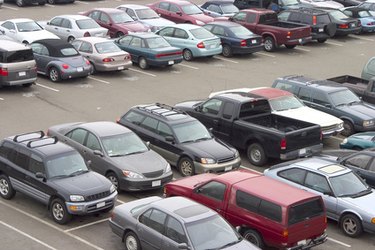
Designing a parking lot according to standard guidelines is essential to ensure a comfortable, safe parking experience. Check with your local authorities for area-specific design standards, but there are many basic guidelines and aspects for you to follow.
Standard dimensions
Video of the Day
Parking stalls should be at least 9 to 10 feet in width, according to the book "Time Saver Standards for Building Types." Perpendicular parking requires a stall depth of 19 feet and a minimum driveway width of 24 feet per car. Parallel parking requires a curb length of 23 feet per car. The customary 60-degree angled parking requires a total horizontal stall depth of 21 feet to 21 feet 6 inches and a minimum driveway width of 18 feet.
Video of the Day
Other Design Guidelines
Use a single stripe either 4 to 6 wide to separate parking stalls. A more efficient design uses two 5-inch-wide stripes separated by 1 foot 6 inches of space as a divider. Keep in mind that the final stall should be 1 foot wider than the others. Minimum driveway widths in parking lots are 12 feet for one-way traffic and 20 feet for two-way traffic.
Accessiblity Guidelines

The Americans with Disabilities Act specifies some rules to be followed in the design of car parking lots. These spaces should be closest to the building and be clearly marked by accessibility signs. It stipulates that a clear accessible aisle of 5 feet be provided for cars and 8 feet for vans. An access route a minimum of 3 feet wide should be provided in front of the parking spaces.
Design considerations
Parking lots should not dominate their surroundings. They should be designed carefully, integrating landscape, signs, pavements, lighting and various textures to break up the monotony of large areas of gravel or pavement. The Manual on Uniform Traffic Control Devices for Streets and Highways will serve as a reference for appropriate signage, striping and markings. Safety and security can be ensured through the installation of CCTV cameras.